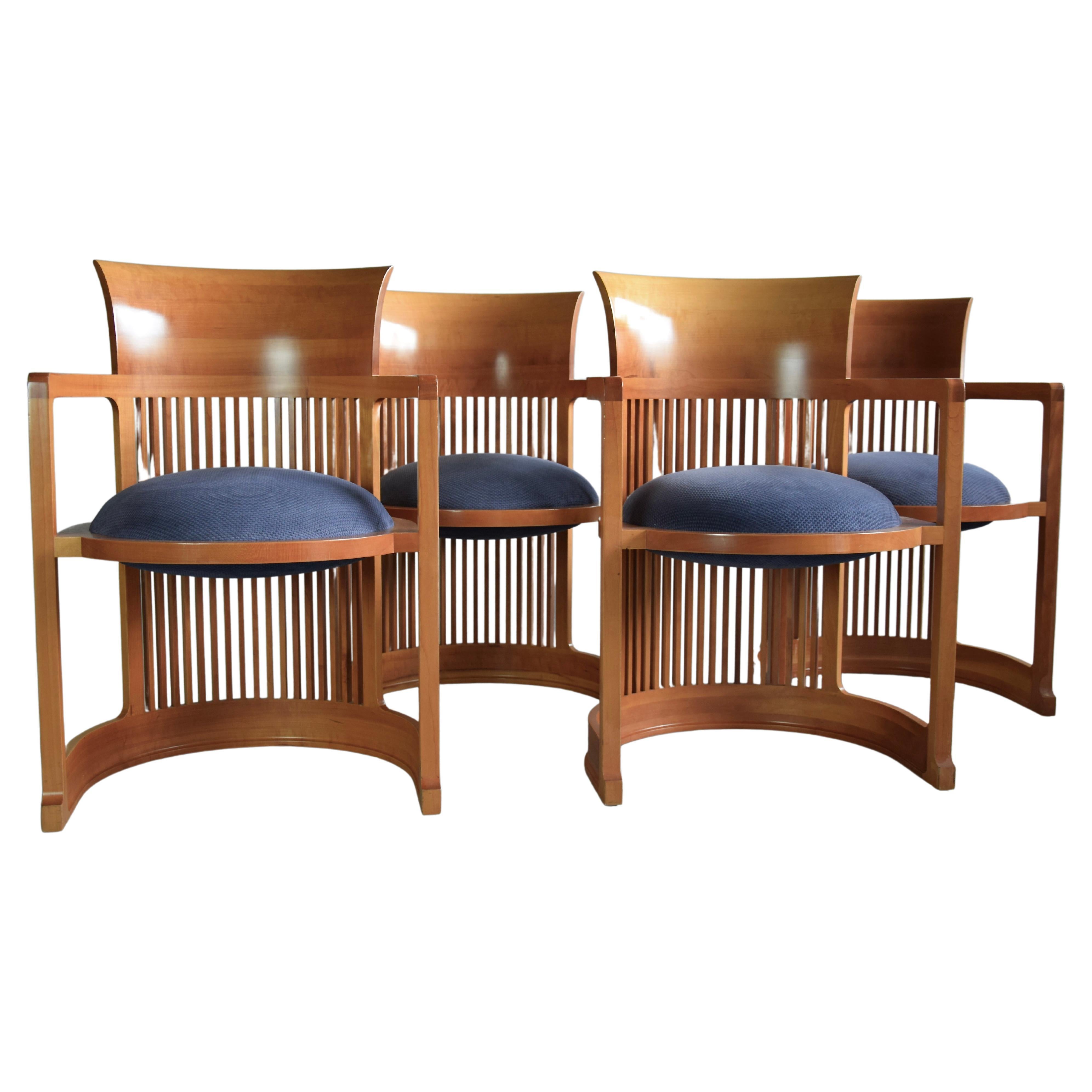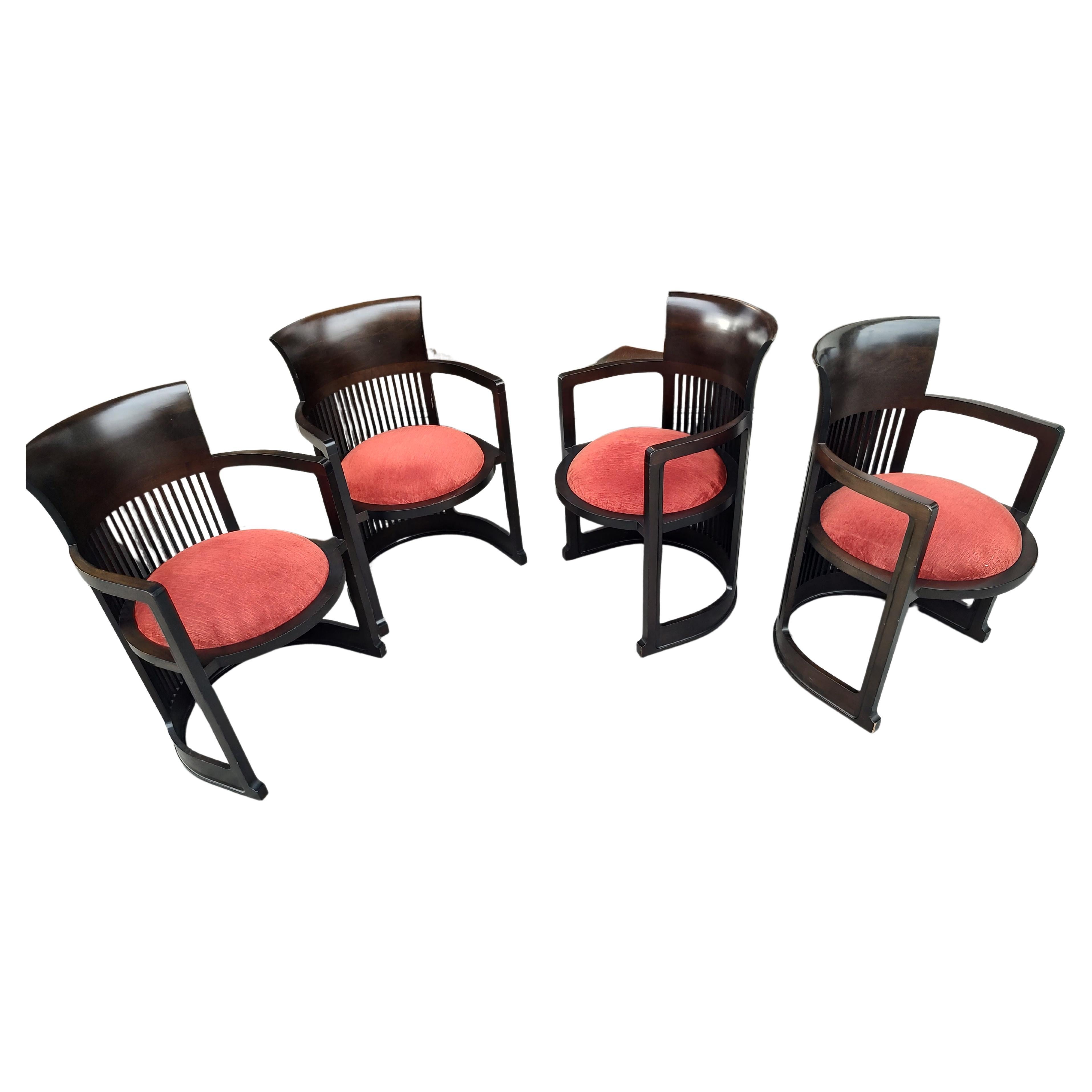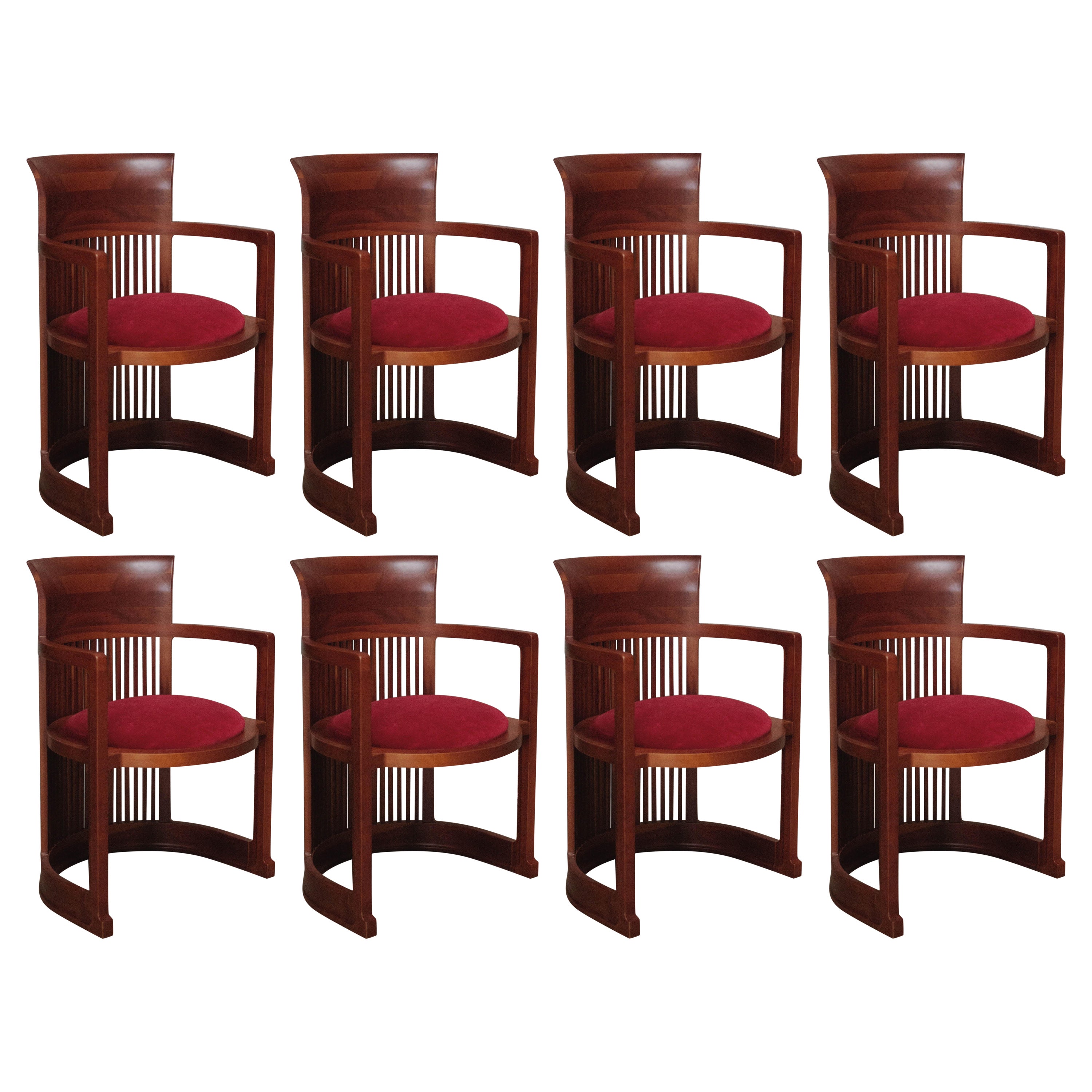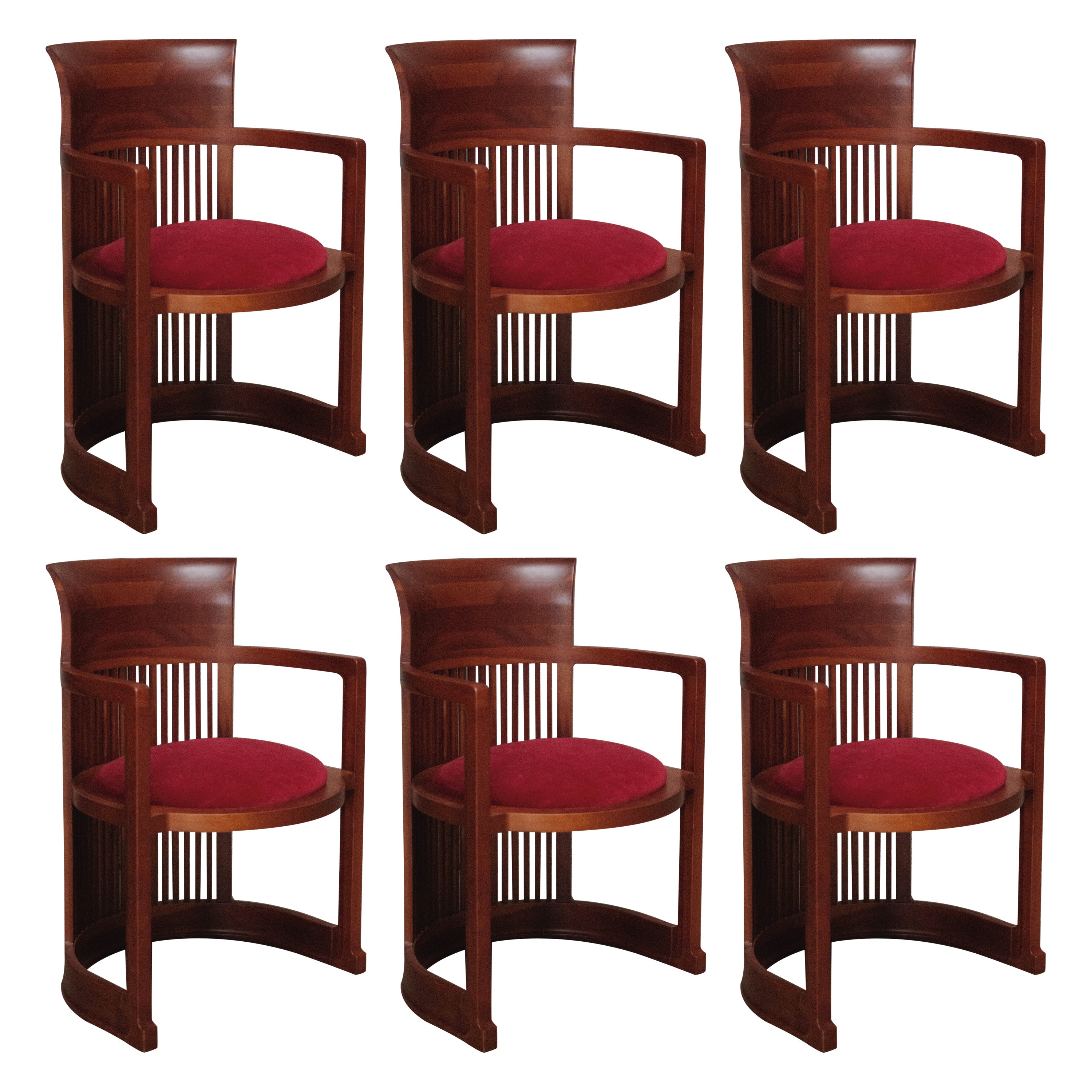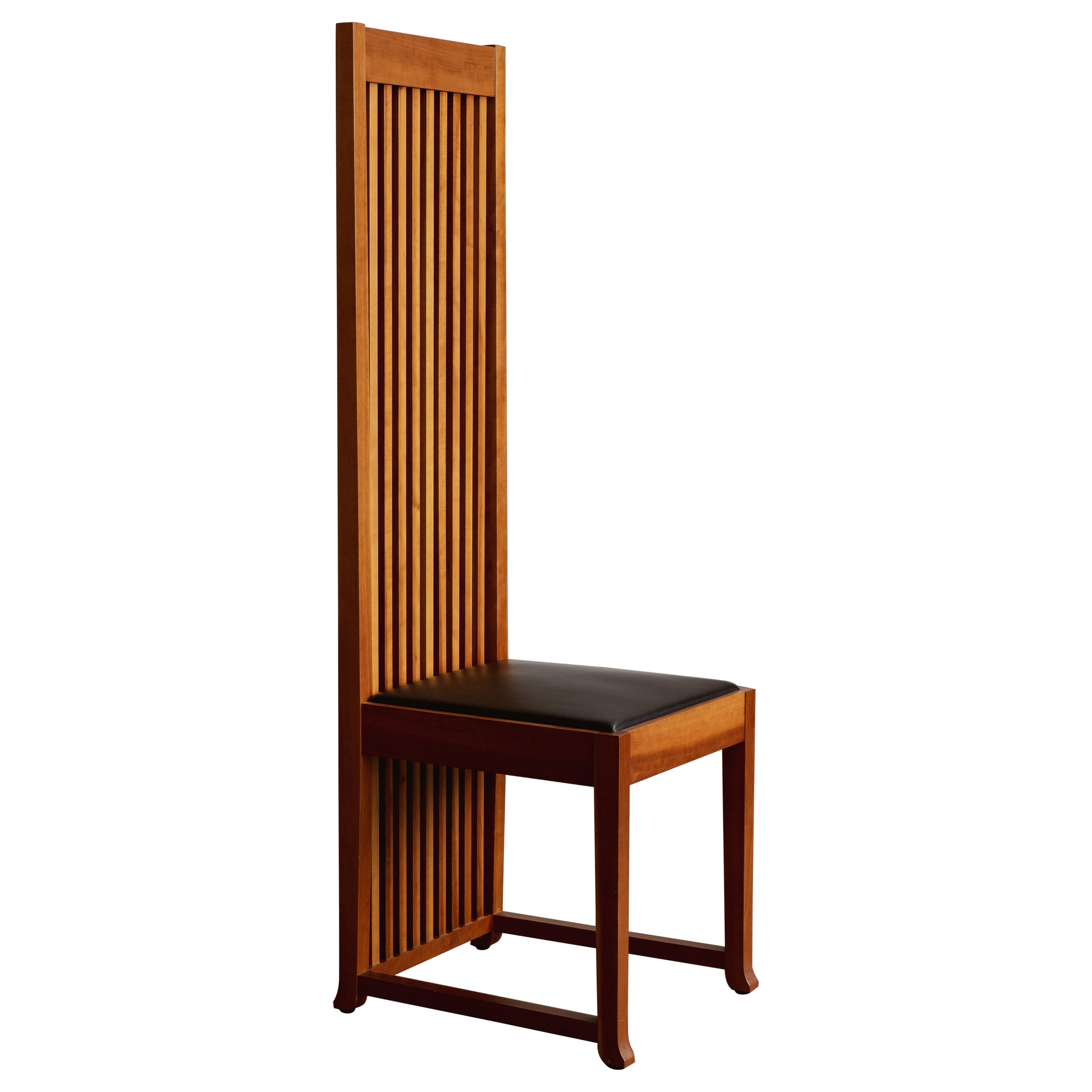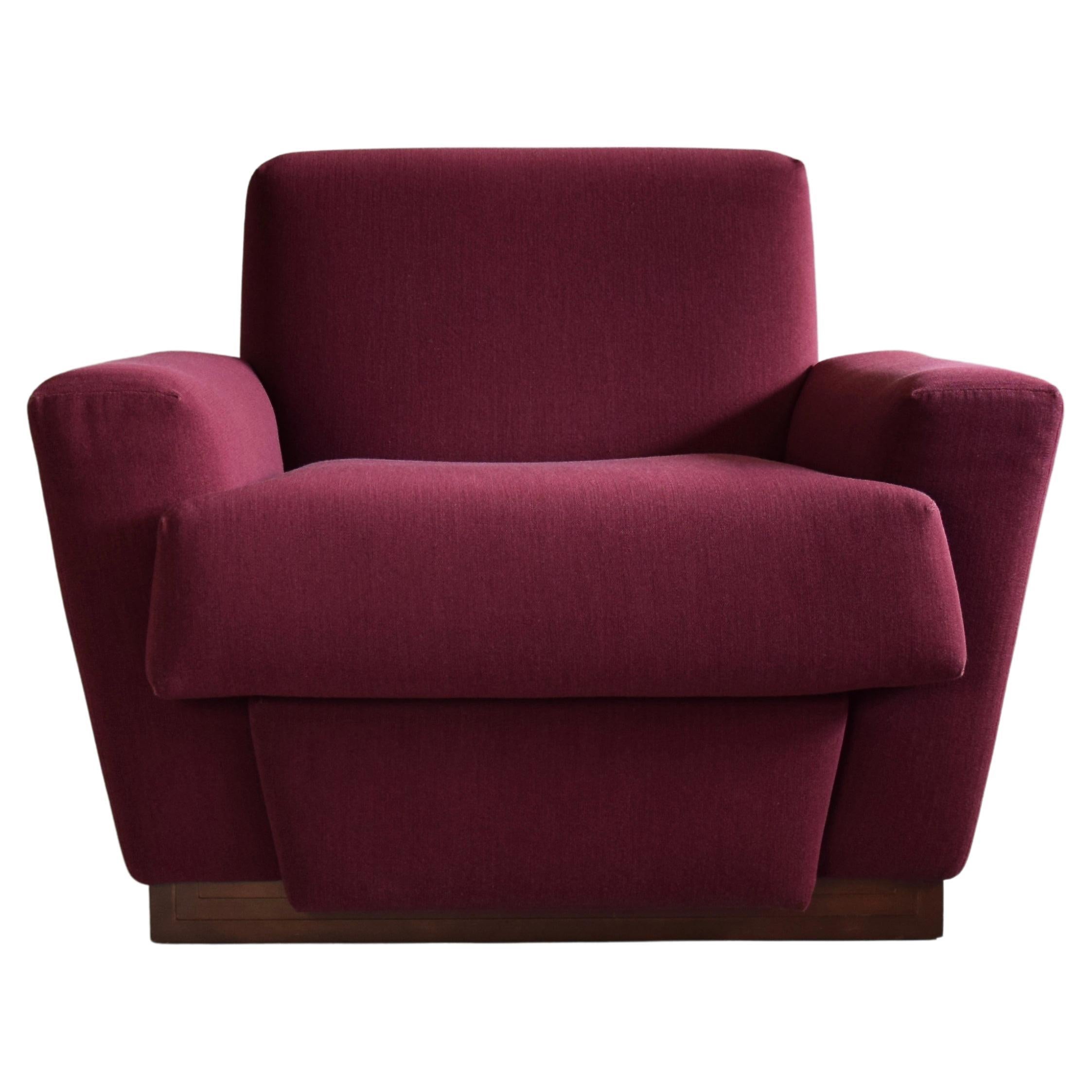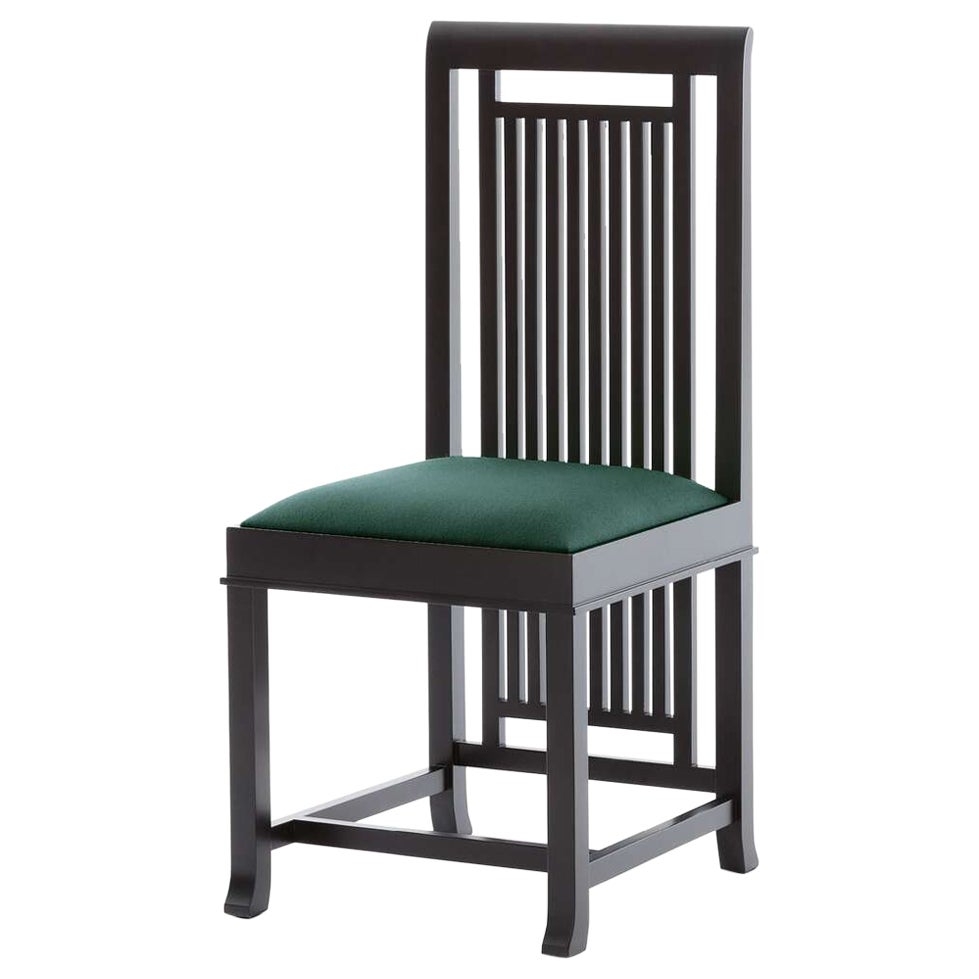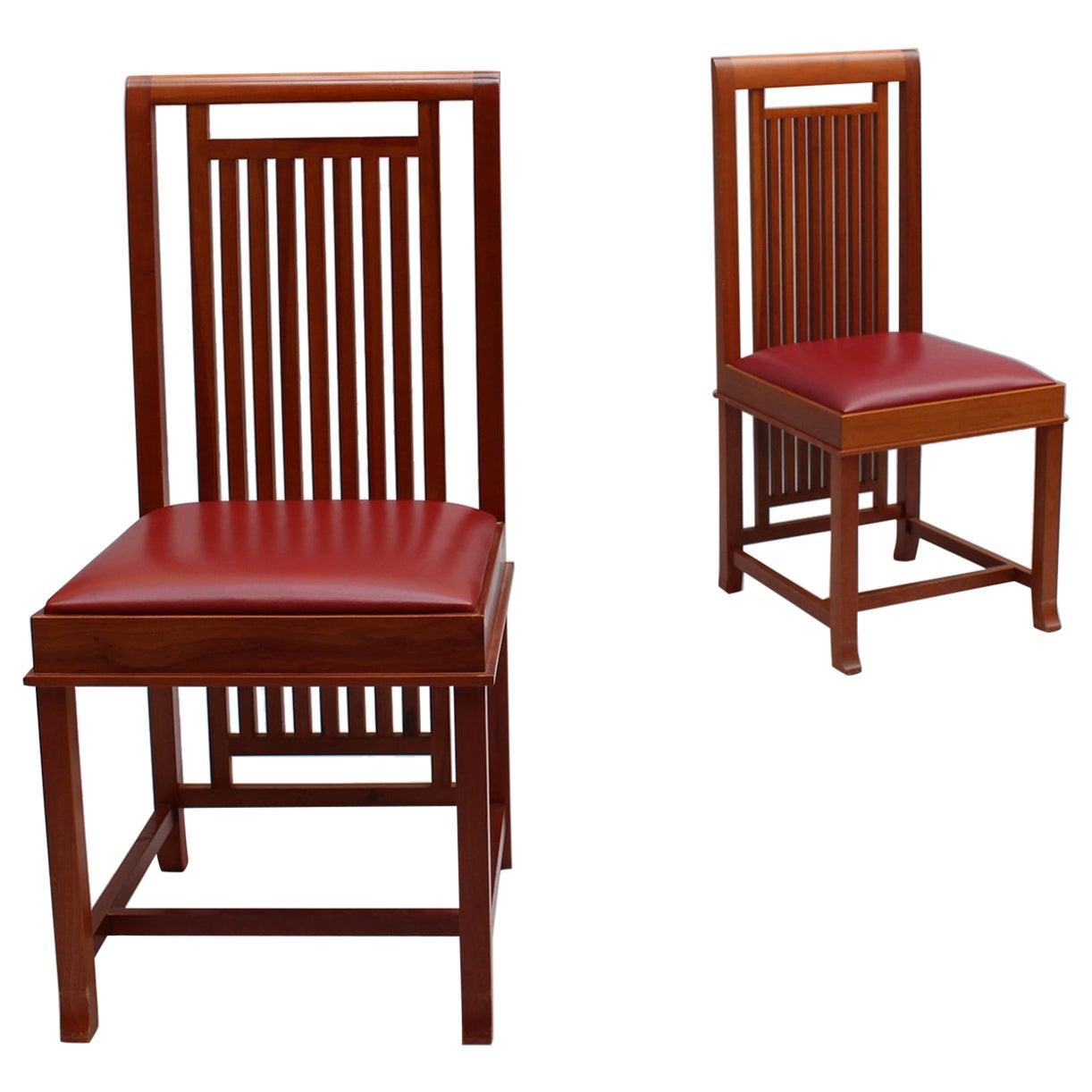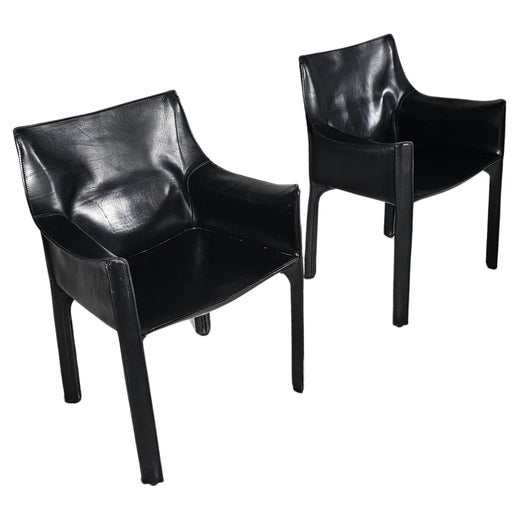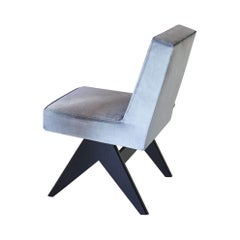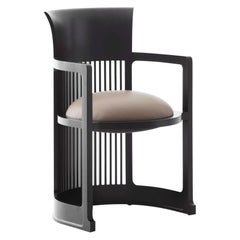
Frank Lloyd Wrigh Barrel Chair Black Finish by Cassina
View Similar Items
Frank Lloyd Wrigh Barrel Chair Black Finish by Cassina
About the Item
- Creator:Cassina (Manufacturer),Frank Lloyd Wright (Designer)
- Dimensions:Height: 31.89 in (81 cm)Width: 21.46 in (54.5 cm)Depth: 21.86 in (55.5 cm)Seat Height: 19.69 in (50 cm)
- Style:Mid-Century Modern (In the Style Of)
- Materials and Techniques:
- Place of Origin:
- Period:
- Date of Manufacture:Contemporary
- Production Type:New & Custom(Current Production)
- Estimated Production Time:13-14 weeks
- Condition:
- Seller Location:Barcelona, ES
- Reference Number:Seller: CS.605.BARRELBLACK.1A.AR.RL.0004751stDibs: LU1427227208732
Frank Lloyd Wright
Without question the greatest architect the United States has ever produced, Frank Lloyd Wright and his philosophy of “organic architecture” — of buildings that exist in harmony with their natural surroundings — had a profound influence on the shape of modern life. Wright gave us some of the most elegant and iconic buildings in America: residences such as Fallingwater, in rural Pennsylvania, the Robie House in Chicago, and Taliesin, Wright’s own home; and masterful institutional structures that include the Unity Temple in Oak Park, Illinois, the Johnson Wax headquarters in Racine, Wisconsin, and the Guggenheim Museum in New York. Whenever possible, Wright designed the furniture for his projects, to ensure an affinity between a building’s exterior and interior.
Wright’s wooden chairs and tables for his “Prairie Houses” of the early 1900s have sleek, attenuated forms, influenced by both the simplicity of traditional Japanese design and the work of Gustav Stickley and other designers of the Arts and Crafts movement. For Taliesin and several residential projects, Wright designed severely geometric chairs that are marvels of reductivist design. He revisited many of these forms in the 1950s in furniture licensed to the firm Henredon, adding a decorative frieze-like element to the edges of tables and stools.
The works on 1stDibs also show how happily Wright embraced new forms and materials. His desks and chairs for Johnson Wax have a streamlined look and use tubular steel to the same effect as designer Warren McArthur, who collaborated with Wright in the interiors of the Arizona Biltmore Hotel. For the Price Tower (1956) in Oklahoma, Wright designed angular wooden desks as well as upholstered pedestal chairs made of chromed steel — audacious furniture for his tallest completed building project.
The beauty of Frank Lloyd Wright’s furniture designs is that while many of us wish we could live in one of his houses, his vintage sofas, storage cabinets and armchairs connect us directly to his architecture, and to the history he made.
Cassina
Furniture manufacturer Cassina is a prolific design house for more reasons than one: It not only owns the licenses to an exquisite collection of iconic chairs, sofas, tables and other pieces from the 20th and 21st centuries but also produces original works that are characterized by innovation and the finest Italian craftsmanship.
Cassina’s illustrious legacy includes being one of the first companies to bring industrial design to Italy in the 1950s. Founded in 1927 in Meda, Italy, by brothers Cesare and Umberto Cassina, the Italian manufacturing giant originally specialized in bespoke woodworking. In nearly a century since its founding, the company has shown incredible foresight about design trends and the evolution of technology.
In 1964, Cassina signed an exclusive licensing agreement to manufacture furniture by Le Corbusier and his collaborators — such as the LC4 chaise longue made with trailblazing French modernist Charlotte Perriand and Pierre Jeanneret — a move that would shape the future of the company. Cassina’s I Maestri collection is an ongoing initiative to restyle landmark designs from the 20th century, such as pieces by Gerrit Rietveld (the Red and Blue armchair from 1918), Charles Rennie Mackintosh, Erik Gunnar Asplund, Franco Albini and Frank Lloyd Wright. The company preserves the intentions and original styles of their designs but adds updated techniques, materials and processes — rendering them the best possible combination of past, present and future. The brand has also worked with contemporary icons like Zaha Hadid, Gio Ponti and Philippe Starck.
Cassina’s original designs are cutting-edge as well. They include pieces for everyday use, the development of which is guided by comfort and the marriage of Italian craftsmanship with industrial technology.
Some of Cassina’s pieces, both from its contemporary and I Maestri collections, can be found in the collections of museums like the Museum of Modern Art and the Vitra Design Museum. In 2014, the company became part of Haworth in its acquisition of Italian furniture group Poltrona Frau, and in 2015, Spanish designer Patricia Urquiola joined Cassina as its art director, leading the brand into its next century of inventive style.
Find a collection of new and vintage Cassina furniture on 1stDibs.
- Pierre Jeanneret Commitee Chair by CassinaBy Cassina, Pierre JeanneretLocated in Barcelona, BarcelonaCommittee chair designed by Pierre Jeanneret circa 1950 , relaunched in 2022. Manufactured by Cassina in Italy. The Committee chair is introduced in the original version and in a...Category
2010s Italian Mid-Century Modern Armchairs
MaterialsWood
$5,750 / item - Pierre Jeanneret Commitee Chair by CassinaBy Cassina, Pierre JeanneretLocated in Barcelona, BarcelonaCommittee chair designed by Pierre Jeanneret circa 1950 , relaunched in 2022. Manufactured by Cassina in Italy. The Committee chair is introduced in the original version and in a...Category
2010s Italian Mid-Century Modern Armchairs
MaterialsWood
$5,750 / item - Pierre Jeanneret Commitee Chair by CassinaBy Cassina, Pierre JeanneretLocated in Barcelona, BarcelonaCommittee Chair designed by Pierre Jeanneret circa 1950 , relaunched in 2022. Manufactured by Cassina in Italy. The Committee Chair is introduced in the original version and in a fr...Category
2010s Italian Mid-Century Modern Armchairs
MaterialsWood
$5,750 / item - Gerrit Rietveld Zeilmaker Version of Black Red and Blue Chair by CassinaBy Cassina, Gerrit RietveldLocated in Barcelona, BarcelonaChair designed by Gerrit Rietveld in 1920. Relaunched in 2015. Manufactured by Cassina in Italy. One of the versions of the iconic model dated 1918. The structure is in black-stained beechwood with white contrasting parts. Seat and back in green lacquered multiplywood. The armchair can have a single seat and backrest cushion in fabric or leather. The black red and blue (Zeilmaker version) born from Rietveld’s chromatic experimentation While researching the origins of the red and blue model in collaboration with the Rietveld heirs, it emerged that the key idea of the first prototypes was based on the concept of spatial organization expressed through the monochrome tones of its elements. The first version was in fact produced in 1918 in completely unpainted wood. In the following years Rietveld proposed various examples, either monochrome or painted in different colors, depending on the requirements of his customers and the interiors for which the chairs were intended. As such, it comes as no surprise to find this 1920s version, presented as part of Cassina’s MutAzioni selection, created for the school teacher Wicher Zeilmaker with a black frame with white ends and a dark green painted seat and backrest. It was Rietveld’s ever-increasing involvement in the De Stijl movement that led him to also use primary colors on this model in 1923, and as such the chair became a veritable manifesto for the emerging neoplastic movement. Initially dubbed slat chair, Rietveld only gave it the name red and blue in the 1950s following its chromatic evolution. The various owners of the different examples used the chair as an abstract-realist sculpture in their interiors and, in some cases, as a simple tool for sitting on, adding cushions to make it more comfortable, just like Cassina offers for the black red and blue today. Production delay: 8-9 weeks Important information regarding images of products: Please note that some of the images show other colors and variations of the model, these images are only to present interior design proposals. The item that is selling is on the first image. Important information regarding color(s) of products: Actual colors may vary. This is due to the fact that every computer monitor, laptop, tablet and phone screen has a different capability to display colors and that everyone sees these colors differently. We try to edit our photos to show all of our products as life-like as possible, but please understand the actual color may vary slightly from your monitor About the designer: Gerrit Thomas Rietveld, born in Utrecht on 24 June 1888, seems possessed of two personalities, each so distinct that one might take his work to be that of more than one artist. The first personality is that seen in the craftsman cabinet-maker working in a primordial idiom, re-inventing chairs and other furniture as if no one had ever built them before him and following a structural code all of his own; the second is that of the architect working with elegant formulas, determined to drive home the rationalist and neoplastic message in the context of European architecture. The two activities alternate, overlap, and fuse in a perfect osmosis unfolding then into a logical sequence. In 1918 Rietveld joined the “De Stijl” movement which had sprung up around the review of that name founded the year before by Theo van Doesburg. The group assimilated and translated into ideology certain laws on the dynamic breakdown of compositions (carrying them to an extreme) that had already been expressed in painting by the cubists: the “De Stijl” artists also carefully studied the architectonic lesson taught by the great Frank Lloyd Wright, whose influence was widely felt in Europe at that time. Collaborating first with Robert van’t Hoff and Vilmos Huszar, then with Theo van Doesburg and Cornelius van Eesteren, Rietveld soon became one of the most distinguished interpreters of the neoplastic message. Among his most important works are: the Schröder house at Utrecht (1924); the “Row Houses” at Utrecht (1931-1934); the Dutch pavilion at the Venice Biennial (1954); the sculpture pavilion in the Rijksmuseum Kröller-Müller at Otterloo and the Van Gogh Museum in Amsterdam (1955). Out of his equally important furniture, Cassina has chosen for its own production: the “Red and Blue” (1918), the “Zig-Zag” (1934), the “Schröder 1...Category
2010s Italian Mid-Century Modern Armchairs
MaterialsWood, Leather
$6,510 Sale Price / item20% Off - Gerrit Rietveld Zeilmaker Version of Black Red and Blue Chair by CassinaBy Cassina, Gerrit RietveldLocated in Barcelona, BarcelonaChair designed by Gerrit Rietveld in 1920. Relaunched in 2015. Manufactured by Cassina in Italy. One of the versions of the iconic model dated 1918. The structure is in black-stained beechwood with white contrasting parts. Seat and back in green lacquered multiplywood. The black red and blue (Zeilmaker version) born from Rietveld’s chromatic experimentation While researching the origins of the red and blue model in collaboration with the Rietveld heirs, it emerged that the key idea of the first prototypes was based on the concept of spatial organization expressed through the monochrome tones of its elements. The first version was in fact produced in 1918 in completely unpainted wood. In the following years Rietveld proposed various examples, either monochrome or painted in different colors, depending on the requirements of his customers and the interiors for which the chairs were intended. As such, it comes as no surprise to find this 1920s version, presented as part of Cassina’s MutAzioni selection, created for the school teacher Wicher Zeilmaker with a black frame with white ends and a dark green painted seat and backrest. It was Rietveld’s ever-increasing involvement in the De Stijl movement that led him to also use primary colors on this model in 1923, and as such the chair became a veritable manifesto for the emerging neoplastic movement. Initially dubbed slat chair, Rietveld only gave it the name red and blue in the 1950s following its chromatic evolution. The various owners of the different examples used the chair as an abstract-realist sculpture in their interiors and, in some cases, as a simple tool for sitting on, adding cushions to make it more comfortable, just like Cassina offers for the black red and blue today. Important information regarding images of products: Please note that some of the images show other colors and variations of the model, these images are only to present interior design proposals. The item that is selling is on the first image. Important information regarding color(s) of products: Actual colors may vary. This is due to the fact that every computer monitor, laptop, tablet and phone screen has a different capability to display colors and that everyone sees these colors differently. We try to edit our photos to show all of our products as life-like as possible, but please understand the actual color may vary slightly from your monitor About the designer: Gerrit Thomas Rietveld, born in Utrecht on 24 June 1888, seems possessed of two personalities, each so distinct that one might take his work to be that of more than one artist. The first personality is that seen in the craftsman cabinet-maker working in a primordial idiom, re-inventing chairs and other furniture as if no one had ever built them before him and following a structural code all of his own; the second is that of the architect working with elegant formulas, determined to drive home the rationalist and neoplastic message in the context of European architecture. The two activities alternate, overlap, and fuse in a perfect osmosis unfolding then into a logical sequence. In 1918 Rietveld joined the “De Stijl” movement which had sprung up around the review of that name founded the year before by Theo van Doesburg. The group assimilated and translated into ideology certain laws on the dynamic breakdown of compositions (carrying them to an extreme) that had already been expressed in painting by the cubists: the “De Stijl” artists also carefully studied the architectonic lesson taught by the great Frank Lloyd Wright, whose influence was widely felt in Europe at that time. Collaborating first with Robert van’t Hoff and Vilmos Huszar, then with Theo van Doesburg and Cornelius van Eesteren, Rietveld soon became one of the most distinguished interpreters of the neoplastic message. Among his most important works are: the Schröder house at Utrecht (1924); the “Row Houses” at Utrecht (1931-1934); the Dutch pavilion at the Venice Biennial (1954); the sculpture pavilion in the Rijksmuseum Kröller-Müller at Otterloo and the Van Gogh Museum in Amsterdam (1955). Out of his equally important furniture, Cassina has chosen for its own production: the “Red and Blue” (1918), the “Zig-Zag” (1934), the “Schröder 1...Category
2010s Italian Mid-Century Modern Armchairs
MaterialsLeather, Wood
- Gerrit Rietveld Zeilmaker Version of Black Red and Blue Chair by CassinaBy Cassina, Gerrit RietveldLocated in Barcelona, BarcelonaChair designed by Gerrit Rietveld in 1920. Relaunched in 2015. Manufactured by Cassina in Italy. One of the versions of the iconic model dated 1918. The structure is in black-stained beechwood with white contrasting parts. Seat and back in green lacquered multiplywood. The armchair can have a single seat and backrest cushion in fabric or leather. The black red and blue (Zeilmaker version) born from Rietveld’s chromatic experimentation While researching the origins of the red and blue model in collaboration with the Rietveld heirs, it emerged that the key IDEA of the first prototypes was based on the concept of spatial organization expressed through the monochrome tones of its elements. The first version was in fact produced in 1918 in completely unpainted wood. In the following years Rietveld proposed various examples, either monochrome or painted in different colors, depending on the requirements of his customers and the interiors for which the chairs were intended. As such, it comes as no surprise to find this 1920s version, presented as part of Cassina’s MutAzioni selection, created for the school teacher Wicher Zeilmaker with a black frame with white ends and a dark green painted seat and backrest. It was Rietveld’s ever-increasing involvement in the De Stijl movement that led him to also use primary colors on this model in 1923, and as such the chair became a veritable manifesto for the emerging neoplastic movement. Initially dubbed slat chair, Rietveld only gave it the name red and blue in the 1950s following its chromatic evolution. The various owners of the different examples used the chair as an abstract-realist sculpture in their interiors and, in some cases, as a simple tool for sitting on, adding cushions to make it more comfortable, just like Cassina offers for the black red and blue today. Important information regarding images of products: Please note that some of the images show other colors and variations of the model, these images are only to present interior design proposals. The item that is selling is on the first image. Important information regarding color(s) of products: Actual colors may vary. This is due to the fact that every computer monitor, laptop, tablet and phone screen has a different capability to display colors and that everyone sees these colors differently. We try to edit our photos to show all of our products as life-like as possible, but please understand the actual color may vary slightly from your monitor About the designer: Gerrit Thomas Rietveld, born in Utrecht on 24 June 1888, seems possessed of two personalities, each so distinct that one might take his work to be that of more than one artist. The first personality is that seen in the craftsman cabinet-maker working in a primordial idiom, re-inventing chairs and other furniture as if no one had ever built them before him and following a structural code all of his own; the second is that of the architect working with elegant formulas, determined to drive home the rationalist and neoplastic message in the context of European architecture. The two activities alternate, overlap, and fuse in a perfect osmosis unfolding then into a logical sequence. In 1918 Rietveld joined the “De Stijl” movement which had sprung up around the review of that name founded the year before by Theo van Doesburg. The group assimilated and translated into ideology certain laws on the dynamic breakdown of compositions (carrying them to an extreme) that had already been expressed in painting by the cubists: the “De Stijl” artists also carefully studied the architectonic lesson taught by the great Frank Lloyd Wright, whose influence was widely felt in Europe at that time. Collaborating first with Robert van’t Hoff and Vilmos Huszar, then with Theo van Doesburg and Cornelius van Eesteren, Rietveld soon became one of the most distinguished interpreters of the neoplastic message. Among his most important works are: the Schröder house at Utrecht (1924); the “Row Houses” at Utrecht (1931-1934); the Dutch pavilion at the Venice Biennial (1954); the sculpture pavilion in the Rijksmuseum Kröller-Müller at Otterloo and the Van Gogh Museum in Amsterdam (1955). Out of his equally important furniture, Cassina has chosen for its own production: the “Red and Blue” (1918), the “Zig-Zag” (1934), the “Schröder 1...Category
2010s Italian Mid-Century Modern Armchairs
MaterialsLeather, Wood
- Frank Lloyd Wright Barrel Chair for CassinaBy Cassina, Frank Lloyd WrightLocated in Berlin, DEThe price given applies to the item as shown in the first picture. Prices vary dependent on the color and material of the chair. A timeless design informed by exceptional constructiv...Category
21st Century and Contemporary Italian Mid-Century Modern Armchairs
MaterialsFabric, Wood
$5,370 / item - Set of Four Early Edition Frank Lloyd Wright Barrel Chairs By Cassina ItalyBy Frank Lloyd WrightLocated in Weesp, NLSet of four early edition Iconic Barrel chairs designed by Frank Lloyd Wright in 1937 and produced by Cassina Italy in the late 1980's early 1990's. The set is in good vintage condit...Category
Vintage 1980s Italian Art Deco Armchairs
MaterialsFabric, Wood
- Mid-Century Modern Arts & Crafts Set of 4 Frank Lloyd Wright Chairs by CassinaBy Frank Lloyd Wright, CassinaLocated in Port Jervis, NYSpectacular set of 4 barrel back chairs designed by Frank Lloyd Wright in 1906-07 and produced in 1936. This is a 1986 collaboration by Cassina of Ital...Category
Vintage 1980s Italian Arts and Crafts Dining Room Chairs
MaterialsFabric, Hardwood
- Frank Lloyd Wright "Barrel" Chairs for Cassina, 1937, Set of 8By Cassina, Frank Lloyd WrightLocated in Lonigo, VenetoFrank Lloyd Wright "Barrel" chairs for Cassina, patinated wood and velvet seat, Italy, 1937, set of 8. A timeless design informed by exceptional constructive complexity, the icon...Category
Vintage 1930s Italian Mid-Century Modern Chairs
MaterialsVelvet, Wood
- Frank Lloyd Wright "Barrel" Chairs for Cassina, 1937, Set of 6By Cassina, Frank Lloyd WrightLocated in Lonigo, VenetoFrank Lloyd Wright "Barrel" chairs for Cassina, patinated wood and velvet seat, Italy, 1937, set of six. A timeless design informed by exceptional constructive complexity, the ic...Category
Vintage 1930s Italian Mid-Century Modern Chairs
MaterialsVelvet, Wood
- Frank Lloyd Wright "Barrel" Chairs for Cassina, 1937, Set of 4By Cassina, Frank Lloyd WrightLocated in Lonigo, VenetoFrank Lloyd Wright "Barrel" chairs for Cassina, patinated wood and velvet seat, Italy, 1937, set of four. A timeless design informed by exceptional constructive complexity, the i...Category
Vintage 1930s Italian Mid-Century Modern Chairs
MaterialsVelvet, Wood

